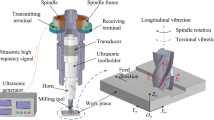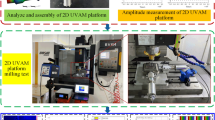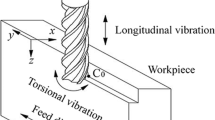Abstract
The continuous optimization of processing technology and evaluation methods is an important way to achieve high processing quality and processing efficiency for difficult-to-process materials. To solve the problem of frequent defects in the slot, the ultrasonic vibration-assisted slot-milling (UVASM) technology was developed for processing titanium alloy. Simultaneously, comparative experiments were carried out between UVASM and conventional slot milling (CSM), in terms of surface features of slot bottom and slot sidewall, cutting force, tool trajectory, chip morphology, and micro-hardness. The results show that uniform vibration micro-texture could significantly improve surface topography of slot bottom in UVASM, while numerous tool feed trajectories and observable machining defects detract from the surface quality in CSM. The UVASM can greatly reduce material spalling and edge breakage, thereby maintaining a smooth and regular edge profile of the slot sidewall. The tool tip trajectories of the two machining methods are highly corresponding to the machining textures of the slot sidewall surface. There is a high-frequency and small-amplitude force fluctuation signal on the axial force waveform in UVASM, which can reduce the instantaneous maximum milling force and milling force in the stable stage by 8.7 and 12.2%, respectively. The UVASM has a better chip breaking effect and surface anti-scratch effect, and the UVASM can obtain higher surface micro-hardness and deeper plastic deformation layer than those CSM. In summary, the multi-dimensional evaluation of slot processing status has been completed, and the processing quality of the slot has been improved.



















Similar content being viewed by others
Data availability
The datasets used or analyzed during the current study are available from the corresponding author on reasonable request.
Code availability
Not applicable.
References
Khalil AK, Yip WS, To S (2022) Theoretical and experimental investigations of magnetic field assisted ultra-precision machining of titanium alloys. J Mater Process Technol 300. https://doi.org/10.1016/j.jmatprotec.2021.117429
Aslantas K, Ülker Ş, Şahan Ö, Pimenov DY, Giasin K (2021) Mechanistic modeling of cutting forces in high-speed microturning of titanium alloy with consideration of nose radius. Int J Adv Manuf Tech. https://doi.org/10.1007/s00170-021-08437-w
Niu Y, Jiao F, Zhao B, Gao G (2019) Investigation of cutting force in longitudinal-torsional ultrasonic-assisted milling of Ti-6Al-4V. Materials 12(12). https://doi.org/10.3390/ma12121955
Yip WS, To S, Sun Z (2021) Hybrid ultrasonic vibration and magnetic field assisted diamond cutting of titanium alloys. J Manuf Processes 62:743–752. https://doi.org/10.1016/j.jmapro.2020.12.037
Gao G, Xia Z, Yuan Z, Xiang D, Zhao B (2021) Influence of longitudinal-torsional ultrasonic-assisted vibration on micro-hole drilling Ti-6Al-4V. Chin J Aeronaut 34(9):247–260. https://doi.org/10.1016/j.cja.2020.06.012
Thepsonthi T, Özel T (2012) Multi-objective process optimization for micro-end milling of Ti-6Al-4V titanium alloy. Int J Adv Manuf Tech 63(9–12):903–914. https://doi.org/10.1007/s00170-012-3980-z
Rinck PM, Gueray A, Kleinwort R, Zaeh MF (2020) Experimental investigations on longitudinal-torsional vibration-assisted milling of Ti-6Al-4V. Int J Adv Manuf Tech 108(11–12):3607–3618. https://doi.org/10.1007/s00170-020-05392-w
Du Y, Yue C, Li X, Liu X, Liang SY (2021) Research on breakage characteristics in side milling of titanium alloy with cemented carbide end mill. Int J Adv Manuf Tech 117(11–12):3661–3679. https://doi.org/10.1007/s00170-021-07938-y
Abdo BMA, Anwar S, El-Tamimi A (2019) Machinability study of biolox forte ceramic by milling microchannels using rotary ultrasonic machining. J Manuf Processes 43:175–191. https://doi.org/10.1016/j.jmapro.2019.05.031
Kumar J (2014) Investigations into the surface quality and micro-hardness in the ultrasonic machining of titanium (ASTM GRADE-1). J Braz Soc Mech Sci Eng 36(4):807–823. https://doi.org/10.1007/s40430-014-0130-6
Zhao B, Chang BQ, Yuan LS, Li PT (2019) Influence of force load on the stability of ultrasonic longitudinal–torsional composite drilling system. Int J Adv Manuf Tech 106(3–4):891–905. https://doi.org/10.1007/s00170-019-04654-6
Fang B, Yuan Z, Li D, Gao L (2021) Effect of ultrasonic vibration on finished quality in ultrasonic vibration assisted micromilling of Inconel718. Chin J Aeronaut 34(6):209–219. https://doi.org/10.1016/j.cja.2020.09.021
Zhu LD, Ni CB, Yang ZC, Liu CF (2019) Investigations of micro-textured surface generation mechanism and tribological properties in ultrasonic vibration-assisted milling of Ti–6Al–4V. Precis Eng 57:229–243. https://doi.org/10.1016/j.precisioneng.2019.04.010
Ni CB, Zhu LD, Yang ZC (2019) Comparative investigation of tool wear mechanism and corresponding machined surface characterization in feed-direction ultrasonic vibration assisted milling of Ti–6Al–4V from dynamic view. Wear 436–437.https://doi.org/10.1016/j.wear.2019.203006
Jain A, Singh G, Jain V, Gupta D (2020) Feasibility analysis for machining serpentine microchannels on glass using rotary ultrasonic milling. Meas 160.https://doi.org/10.1016/j.measurement.2020.107844
Ahmed F, Ko TJ, Kurniawan R, Kwack Y (2021) Machinability analysis of difficult-to-cut material during ultrasonic vibration-assisted ball end milling. Mater Manuf Processes 36(15):1734–1745. https://doi.org/10.1080/10426914.2021.1944194
Baraheni M, Amini S (2019) Investigation on rotary ultrasonic assisted end grinding of silicon nitride ceramics. SN Appl Sci 1(12). https://doi.org/10.1007/s42452-019-1594-x
Sajjady SA, Abadi HNH, Amini S, Nosouhi R (2016) Analytical and experimental study of topography of surface texture in ultrasonic vibration assisted turning. Mater Des 93:311–323. https://doi.org/10.1016/j.matdes.2015.12.119
Ding H, Ibrahim R, Kai C, Chen SJ (2010) Experimental study on machinability improvement of hardened tool steel using two dimensional vibration-assisted micro-end-milling. Int J Mach Tools Manuf 50(12):1115–1118
Lu H, Zhu LD, Yang ZC, Lu H, Yan BL, Hao YP, Qin SQ (2021) Research on the generation mechanism and interference of surface texture in ultrasonic vibration assisted milling. Int J Mech Sci 208. https://doi.org/10.1016/j.ijmecsci.2021.106681
Ni CB, Zhu LD (2020) Investigation on machining characteristics of TC4 alloy by simultaneous application of ultrasonic vibration assisted milling (UVAM) and economical-environmental MQL technology. J Mater Process Technol 278. https://doi.org/10.1016/j.jmatprotec.2019.116518
Chen WQ, Zheng L, Xie WK, Yang K, Huo DH (2019) Modelling and experimental investigation on textured surface generation in vibration-assisted micro-milling. J Mater Process Technol 266:339–350. https://doi.org/10.1016/j.jmatprotec.2018.11.011
Liu JJ, Jiang XG, Han X, Gao Z, Zhang DY (2018) Effects of rotary ultrasonic elliptical machining for side milling on the surface integrity of Ti-6Al-4V. Int J Adv Manuf Tech 101(5–8):1451–1465. https://doi.org/10.1007/s00170-018-2847-3
Chen G, Ren CZ, Zou YH, Qin XD, Lu LP, Li SP (2019) Mechanism for material removal in ultrasonic vibration helical milling of Ti 6Al 4V alloy. Int J Mach Tools Manuf 138:1–13. https://doi.org/10.1016/j.ijmachtools.2018.11.001
Barry J, Byre J, Lennon D (2001) Observations on chip formation and acoustic emission in machining Ti–6Al–4V alloy. Int J Mach Tools Manuf 41:1055–1070
Sun S, Brandt M, Dargusch MS (2009) Characteristics of cutting forces and chip formation in machining of titanium alloys. Int J Mach Tools Manuf 49(7–8):561–568. https://doi.org/10.1016/j.ijmachtools.2009.02.008
Moghaddas A (2021) Characterization of thrust force, temperature, chip morphology and power in ultrasonic-assisted drilling of aluminium 6061. Int J Adv Manuf Tech. https://doi.org/10.1007/s00170-021-07742-8
Jung HJ, Hayasaka T, Shamoto E, Xu LJ (2020) Suppression of forced vibration due to chip segmentation in ultrasonic elliptical vibration cutting of titanium alloy Ti–6Al–4V. Precis Eng 64:98–107. https://doi.org/10.1016/j.precisioneng.2020.03.017
Ren WF, Xu JK, Lin JQ, Yu ZJ, Yu P (2019) Research on homogenization and surface morphology of Ti-6Al-4V alloy by longitudinal-torsional coupled ultrasonic vibration ball-end milling. Int J Adv Manuf Tech 104:301–313. https://doi.org/10.1007/s00170-019-03668-4
Yang D, Liu Z (2017) Surface integrity generated with peripheral milling and the effect on low-cycle fatigue performance of aeronautic titanium alloy Ti-6Al-4V. The Aeronautical Journal 122(1248):316–332. https://doi.org/10.1017/aer.2017.136
Abbasi SA, Feng P, Ma Y, Zhang J, Yu D, Wu Z (2016) Influence of microstructure and hardness on machinability of heat-treated titanium alloy Ti-6Al-4V in end milling with polycrystalline diamond tools. Int J Adv Manuf Tech 86(5–8):1393–1405. https://doi.org/10.1007/s00170-015-8245-1
Chen G, Zou YH, Qin XD, Liu J, Feng Q, Ren CZ (2020) Geometrical texture and surface integrity in helical milling and ultrasonic vibration helical milling of Ti-6Al-4V alloy. J Mater Process Technol. https://doi.org/10.1016/j.jmatprotec.2019.116494
Niu Y, Jiao F, Zhao B, Wang D (2017) Multiobjective optimization of processing parameters in longitudinal-torsion ultrasonic assisted milling of Ti-6Al-4V. Int J Adv Manuf Tech 93(9–12):4345–4356. https://doi.org/10.1007/s00170-017-0871-3
Lesyk DA, Martinez S, Mordyuk BN, Dzhemelinskyi VV, Lamikiz A, Prokopenko GI (2019) Effects of laser heat treatment combined with ultrasonic impact treatment on the surface topography and hardness of carbon steel AISI 1045. Opt Laser Technol 111:424–438. https://doi.org/10.1016/j.optlastec.2018.09.030
Ying N, Feng J, Bo Z, Guofu G, Jing-jing N (2020) Theoretical investigation of machining-induced residual stresses in longitudinal torsional ultrasonic–assisted milling. Int J Adv Manuf Tech 108(11–12):3689–3705. https://doi.org/10.1007/s00170-020-05495-4
Li H, He GY, Qin XD, Wang GF, Lu C, Gui LJ (2014) Tool wear and hole quality investigation in dry helical milling of Ti-6Al-4V alloy. Int J Adv Manuf Tech 71(5–8):1511–1523. https://doi.org/10.1007/s00170-013-5570-0
Zou YH, Chen G, Lu LP, Qin XD, Ren CZ (2019) Kinematic view of cutting mechanism in hole-making process of longitude-torsional ultrasonic assisted helical milling. Int J Adv Manuf Tech 103(1–4):267–280. https://doi.org/10.1007/s00170-019-03483-x
Nath C, Rahman M (2008) Effect of machining parameters in ultrasonic vibration cutting. Int J Mach Tools Manuf 48(9):965–974. https://doi.org/10.1016/j.ijmachtools.2008.01.013
Li X, Zhao P, Niu Y, Guan C (2016) Influence of finish milling parameters on machined surface integrity and fatigue behavior of Ti1023 workpiece. Int J Adv Manuf Tech 91(1–4):1297–1307. https://doi.org/10.1007/s00170-016-9818-3
Teimouri R, Liu Z (2020) An analytical prediction model for residual stress distribution and plastic deformation depth in ultrasonic-assisted single ball burnishing process. Int J Adv Manuf Tech 111(1–2):127–147. https://doi.org/10.1007/s00170-020-06068-1
Funding
This study was supported by the Fundamental Research Funds for the Central Universities of Central South University (no. 2021zzts0130).
Author information
Authors and Affiliations
Contributions
All authors contributed to the study’s conception and design. Material preparation and data collection were performed by Baoqi Chang and Zhaoxi Yi. Ji-an Duan and Xiaobing Cao participated in the data analysis and logical analysis of the article. The first draft of the manuscript was written by Baoqi Chang, and all authors commented on previous versions of the manuscript. All authors read and approved the final manuscript.
Corresponding authors
Ethics declarations
Ethics approval
The content studied in this article belongs to the field of ultrasonic processing and does not involve humans and animals. This article strictly follows the accepted principles of ethical and professional conduct.
Consent to participate
My co-authors and I would like to opt into In Review.
Consent for publication
I agree with the copyright transfer statement.
Competing interests
The authors declare no competing interests.
Additional information
Publisher's Note
Springer Nature remains neutral with regard to jurisdictional claims in published maps and institutional affiliations.
Rights and permissions
Springer Nature or its licensor holds exclusive rights to this article under a publishing agreement with the author(s) or other rightsholder(s); author self-archiving of the accepted manuscript version of this article is solely governed by the terms of such publishing agreement and applicable law.
About this article
Cite this article
Chang, B., Yi, Z., Cao, X. et al. Surface feature and material removal in ultrasonic vibration-assisted slot-milling of Ti–6Al–4 V titanium alloy. Int J Adv Manuf Technol 122, 2235–2251 (2022). https://doi.org/10.1007/s00170-022-09970-y
Received:
Accepted:
Published:
Issue Date:
DOI: https://doi.org/10.1007/s00170-022-09970-y




